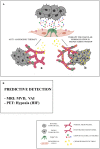Anti-angiogenic Therapy in Cancer: Downsides and New Pivots for Precision Medicine
- PMID: 28111549
- PMCID: PMC5216034
- DOI: 10.3389/fphar.2016.00519
Anti-angiogenic Therapy in Cancer: Downsides and New Pivots for Precision Medicine
Abstract
Primary solid tumors originate close to pre-existing tissue vasculature, initially growing along such tissue blood vessels, and this phenomenon is important for the metastatic potential which frequently occurs in highly vascularized tissues. Unfortunately, preclinic and clinic anti-angiogenic approaches have not been very successful, and multiple factors have been found to contribute to toxicity and tumor resistance. Moreover, tumors can highlight intrinsic or acquired resistances, or show adaptation to the VEGF-targeted therapies. Furthermore, different mechanisms of vascularization, activation of alternative signaling pathways, and increased tumor aggressiveness make this context even more complex. On the other hand, it has to be considered that the transitional restoration of normal, not fenestrated, microvessels allows the drug to reach the tumor and act with the maximum efficiency. However, these effects are time-limited and different, depending on the various types of cancer, and clearly define a specific "normalization window." So, new horizons in the therapeutic approaches consist on the treatment of the tumor with pro- (instead of anti-) angiogenic therapies, which could strengthen a network of well-structured blood vessels that facilitate the transport of the drug.
Keywords: anti-angiogenic therapy; hypoxia detection; microvascular architecture; pericytes; tumor angiogenesis; tumor endothelial cells (TECs); vascular normalization.
Figures

References
-
- Allegra C. J., Yothers G., O’Connell M. J., Sharif S., Petrelli N. J., Lopa S. H., et al. (2013). Bevacizumab in stage II-III colon can- cer: 5-year update of the National Surgical Adjuvant Breast and Bowel Project C-08 trial. J. Clin. Oncol. 31 359–364. 10.1200/JCO.2012.44.4711 - DOI - PMC - PubMed
Publication types
LinkOut - more resources
Full Text Sources
Other Literature Sources

